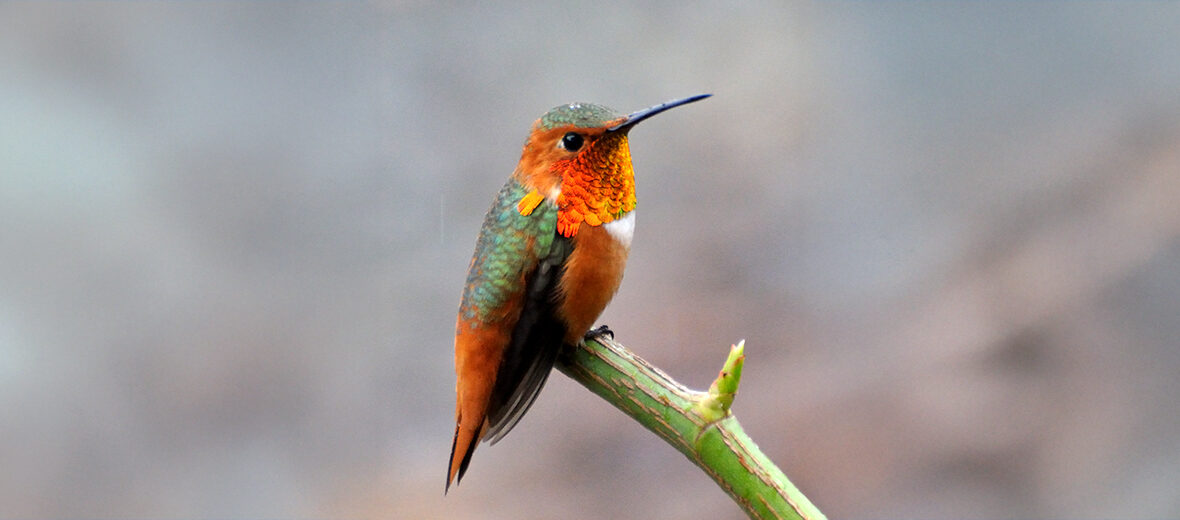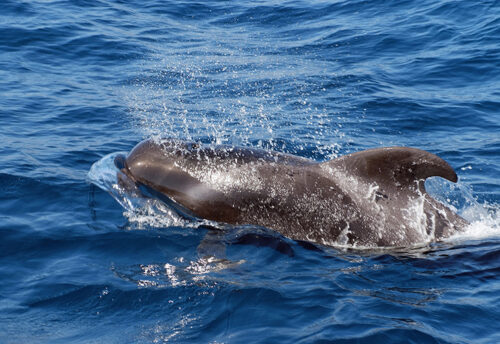
The Allen’s hummingbird known for their energetic performances and incredible colors make them a favorite for bird watchers. These birds breed along the west coast of the United States and migrate all the way down to central Mexico to spend the winter months. Without many threats, sans habitat loss and destruction at the hands of residential and commercial developments, and predation by domestic and feral cats, these birds are not only abundant but increasing in numbers. The IUCN lists these hummingbirds as Least Concern.
First the Stats…
Scientific name: Selasphorus sasin
Weight: Up to .14 ounce
Length: Up to 3.5 inches
Wingspan: Up to 4.3 inches
Lifespan: Up to 5.11 years
Now on to the Facts!
1.) These hummingbirds number an estimated 1,500,000+ individuals.
2.) While males are vibrantly colored, females and juveniles lack the bold colorations and are so similarly colored that they are nearly indistinguishable.
3.) The lack of a notch in the second rectrix (flight feathers) is deemed an important field mark to tell the adult male Allen’s hummingbird apart from rufous hummingbird.
4.) They were first described by the French naturalist René Lesson in 1829.
5.) These critters are part of the family Trochilidae, which includes over 300 species of hummingbirds found primarily in North America, Central America, and South America.
But wait, there’s more on the Allen’s hummingbird!
6.) The common name is an ode to Charles Andrew Allen, an American collector and taxidermist who identified these hummingbirds in 1879 in Nicasio, California.
7.) There are 2 recognized subspecies: S. s. sasin and S. s. sedentarius.
Did you know…?
The specific epithet is a Wakashan or Nootka Native American name for a hummingbird.
8.) Males and females migrate at different times. Males head back up north first, earlier in the year; while females head north closer to spring. This helps prevent competition for available food.
9.) Even though their populations are now increasing, for a while their populations were decreasing by up to 80%, in circa 1960s, due to habitat loss and destruction.
10.) The courtship flight of males is described as a frantic back-and-forth flight arc of about 25 feet similar to the motion of a swinging pendulum, followed by a high-speed dive from about 100 feet, during which tail feathers emit a characteristic sharp flutter to even further attract a female.
But wait, there’s still more on the Allen’s hummingbird!
11.) Males are known for their defensive and even aggressive behaviors, driving off competitor males and even risking it all by chasing off birds of prey like kestrels and hawks!
12.) Females usually reside in forests with larger trees, like oak-pines, Douglas firs, and redwoods, providing ample protection and nesting materials.
Did you know…?
Like other birds, they use their feet as a means of thermoregulation; in colder months, they tuck their feet into their feathers during flight, which keeps them warmer, and (in contrast) in warmer months they fly with their feet dangling to precipitate cooling.
13.) Nests are constructed from plant fibers, down, and weed stems. They then coat the nest with lichens and spider webs to give it more structure.
14.) Females lay up to 2 eggs that hatch in up to 17 days.
15.) Hatchlings fledge and leave the nest in up to 3 weeks.
But wait, there’s still a little more on the Allen’s hummingbird!
16.) Like all hummingbirds, Allen’s hummingbirds feast on nectar from flowers, while also eating a variety of ants, smaller beetles, flies, spiders, and tiny wasps for protein.
17.) Sometimes insects are taken on the wing (in mid flight).
18.) Like other hummers, these critters are diurnal (active during the day).
Now a Short Allen’s Hummingbird Video!
Be sure to share & comment below! Also, check out the Critter Science YouTube channel. Videos added regularly!

Want to suggest a critter for me to write about? Let me know here.
Some source material acquired from: Wikipedia & IUCN
Photo credit: M. Shattock



